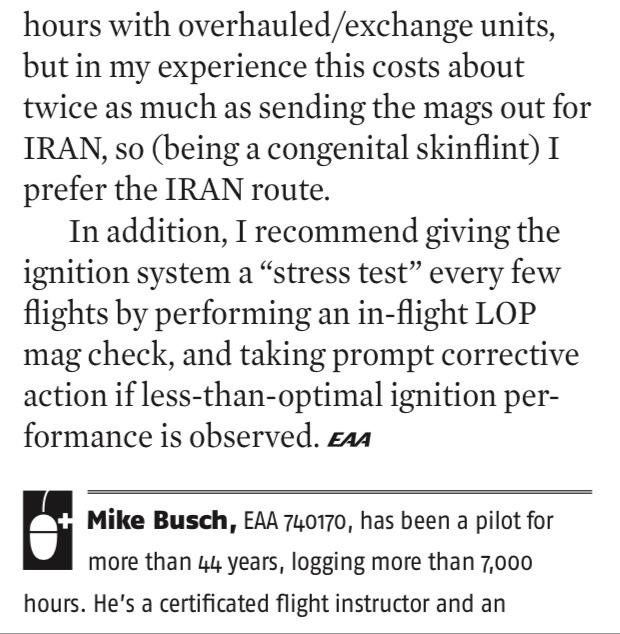It’s not unreasonable fear to advocate not messing with a smooth running engine in flight.
The unreasonable / irrational is when you:
1. Hopefully already did a good mag check on the ground per the POH (or taxied back to have it looked at if you couldn’t clear your fouled plugs because you were running too rich).
2. Don’t have a rough running engine
3. Feel like you need to mess with a perfectly fine running engine by inducing irrational temporarily reduced ignition efficiency just because some MX guy put an idea you don’t apparently understand in your head.
My experience with many pilots (as an instructor) is that they often don't notice the subtle warning signals an engine makes. A bit of roughness or vibration. A little hesitation sometimes. If pilots checked their mags in flight once in a great while they might suddenly realize that one of them isn't all that healthy and get it looked at, instead of running stuff until it fails at some inconvenient time and place.
I used to take the flight school airplanes out once in a while and fly them myself. I'd find some stuff that needed attention, sometimes serious stuff. I'd mention it to the other instructors and they'd often say "Oh, that's been doing that for a while. Thought it was normal." So why didn't they ask about it? Ignorance of the meaning of the little signals that mechanical or electrical stuff makes when it's not happy.
We often see threads started here about someone who's had a mag or an alternator or a vacuum pump fail in flight. There is no excuse for that, given that airframe manufacturers recommend, in their service manuals, that these things be checked periodically. Vac pumps are supposed to be replaced every 600 hours, typically, or a pump with vane wear inspection provisions be installed and the checks done periodically and failure is thereby avoided. Alternator brushes are supposed to get checked at 500-hour intervals. Mags are 500-hour inspection items. These things aren't mandated by the regulations so in most cases they don't get done and they inevitably let the pilot down. I ran the maintenance program in that flight school, and we did all those recommended inspections and never had inflight failures of mags or alternators or vacuum pumps. Many thousands of hours without a failure.
So don't fool with your switch. Nobody is forcing you. There are numerous posters in this thread that have done and still do it and sometimes find flaws that weren't apparent on the ground run. You'll just have to let them be. Worse, some of them even fly taildraggers, a notoriously dangerous pursuit in the view of many POAers.
Around 44 years ago I had an engine fail in flight. I was towing gliders. On one pull, while the rope was being connected, the idling engine was making a whistling sound. Unusual. But it went away when I opened the throttle a little, so I didn't worry about it. Took off, towed the glider to altitude, and closed the throttle when he cut loose and I glided back down to pattern altitude. Opened the throttle, and no power came forth. None at all. No amount of fooling with anything made any difference. Made a tight circuit and landed. This was a Gipsy Major engine, with a downdraft carb sitting on the intake manifold alongside the cylinders. The whistling was the carb gasket howling as air was sucked past it at idle, since the four bolts holding the carb were backing out. Hadn't been lockwired. Three of the four fell out entirely during the climb, and when I closed the throttle the linkage (pushrods and bellcranks, not a cable) pulled the carb backward and it hung there, cocked on the remaining bolt. If I had been older and wiser I would have shut the thing down when I first heard that whistle and had someone look at it. But I was young and ignorant. That was a taildragger, too. Dangerous living.





